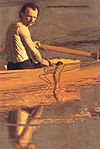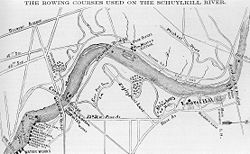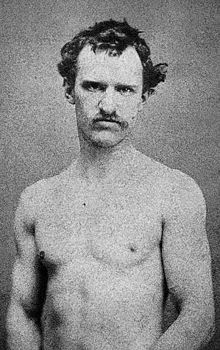- Max Schmitt in a Single Scull
-
Max Schmitt in a Single Scull 
Artist Thomas Eakins Year 1871 Type Oil on canvas Dimensions 82.6 cm × 117.5 cm (32½ in × 46¼ in) Location Metropolitan Museum of Art, New York City Max Schmitt in a Single Scull (also known as The Champion Single Sculls or The Champion, Single Sculls) is an 1871 painting by Thomas Eakins in the permanent collection of the Metropolitan Museum of Art. Set on the Schuylkill River in Philadelphia, Pennsylvania, it celebrates the victory of Eakins's friend Max Schmitt in the October 5, 1870, single sculls competition.
Contents
The Scull
Max Schmitt (1843–1900) had gone to high school with Eakins, and the two were close friends. Schmitt was a member of the Pennsylvania Barge Club — as, it is presumed, was Eakins — one of nine men's clubs in the Schuylkill Navy, and twelve that rowed on the river. The Schuylkill Navy was organized in 1858, with approximately 300 members, and began hosting annual regattas in 1859 (with a 4-year hiatus for the American Civil War). Initially, the races were for 6-oared and 4-oared gigs and barges, but a new kind of lightweight craft was rapidly gaining popularity: the racing scull.
 Detail of Schmitt. Note the riggers.
Detail of Schmitt. Note the riggers.
Sculls, or shells, were narrower, longer, and a lot faster. Gigs had their oarlocks mounted on the sides (like a rowboat), but sculls had them a couple feet outside the boat thanks to riggers, triangular braces that projected out from the sides. This increased the efficiency of every stroke, and led to much longer oars. Meanwhile, boats got longer and hulls got narrower, until they were as narrow as was possible while still retaining sufficient buoyancy and balance.
Schmitt was an early convert to sculls, and owned his own, named "Josie" (after his sister). In September 1866, the Schuylkill Navy's annual regatta first featured a single-sculls race (3 miles, 1 turn), and Schmitt won it. He won again the following July, but came in second to another Pennsylvania Barge rower in a longer (4 miles, 1 turn) race in September 1867. He did not participate in 1868, when fellow Pennsylvania Barge rowers won first and second. Schmitt won the single-sculls title again in June 1869, but came in second to an Undine Barge Club rower in September.
The Race
In 1870 the four top rowers in the Schuylkill Navy all belonged to the Pennsylvania Barge Club: Schmitt, Charles Brossman (who had won the title in 1868, and beaten Schmitt in the 4-mile race in 1867), Austin Street (who had placed second in 1868), and John Lavens, Jr.
The course was 3 miles long: beginning near Turtle Rock (Turtle Rock Light is the lighthouse at the northwest end of Boathouse Row), proceeding upriver under the Girard Avenue and Pennsylvania Railroad Connecting Bridges to a stake near the Columbia Railroad Bridge, making a 180-degree turn around the stake, and then heading downriver back to the starting line.
"Starting well together, Schmitt soon drew ahead followed by Street, Brossman and Lavens. When under the Girard Avenue Bridge, Brossman and Street fouled, the oars of one resting on the boat of the other. Schmitt was now three full lengths ahead. Street and Brossman again fouled in the attempt of the former to turn the eastern stake, thus crossing Brossman's bow. Schmitt had no trouble in maintaining the advantage he had gained, and won easily."[1]
Schmitt not only re-established himself as the pre-eminent rower on the Schuylkill River, he set a new record, completing the 3-mile, 1-turn course in 20:00 minutes.
Schmitt did not defend his title the following year, and Lavens won with a time of 19:59 minutes, shaving one second off Schmitt's record. Schmitt raced one-on-one against Lavens for the single-sculls championship in 1872, and won (but did not beat Lavens's record). Schmitt sat out 1873, and Lavens won again. The two raced one-on-one again in 1874, and Schmitt won again. Having regained the championship (but not the record) and never having been defeated by Lavens, Schmitt retired from single-sculls competition. But that same year, he and Lavens joined forces to help win the Four-Oared Shell competition for the Pennsylvania Barge Club. Another Eakins painting (unfinished) may commemorate that June 17, 1874 victory.
The Painting
Eakins returned to Philadelphia in July 1870, following four years of study at the École des Beaux-Arts in Paris. He was a witness to Schmitt's victory in October. The painting's composition echoes the event by reproducing the weather conditions/position of the sun at the date and time of Schmitt's triumph.
Schmitt is depicted rowing upstream; his location is just south of the Columbia Railroad Bridge, the midpoint of the race. Eakins, who was also a keen rower, included himself as the sculler in the middle distance.
The Reception
The painting was exhibited only once during Eakins's lifetime; at the Union League of Philadelphia for four days in April 1871. The reviews were mixed. From the Philadelphia Bulletin:
"The latter artist [Thomas Eakins], who has lately returned from Europe and the influence of Gérôme, has also a picture entitled 'The Champion Single Sculls' (No. 137), which, though peculiar, has more than ordinary interest. The Artist, in dealing so boldly and broadly with the commonplace in nature, is working upon well-supported theories, and despite a somewhat scattered effect, gives promise of a conspicuous future." [2]
From the Philadelphia Inquirer:
"Thomas Eakins shows two, a portrait and a river scene, entitled 'The Champion Sculls.' While manifesting a marked ability, especially in the painting of the rower in the foreground, the whole effect is scarely satisfactory. The light on the water, on the rower and on the trees lining the bank indicates that the sun is blazing fiercely, but on looking upward one perceives a curiously dull leaden sky."[3]
"This painting, the first of 24 rowing paintings that Eakins completed over the course of four years, was the first time rowing was the focus of serious art. However, the stuffy Philadelphia critics didn’t take well to Eakins’ subject matter, even though rowing was, at the time, one of the most popular sports. A critic remarked that his subject matter was 'a shock to the artistic conventionalities of the city'."[4]
-
G-44A Eakins's drawing of the Girard Avenue Bridge, Hirshhorn Museum and Sculpture Garden.
-
G-64 Sketch of Max Schmitt (circa 1870-71), Philadelphia Museum of Art.
-
G-63 Oarsmen on the Schuylkill (The Pennsylvania Barge Four) (circa 1874), Brooklyn Museum. From left to right: Oscar F. West (bow), Frank Henderson, Max Schmitt, John Lavens, Jr. (stroke).
References
- Helen A. Cooper, et al., Thomas Eakins: The Rowing Pictures (New Haven: Yale University Press, 1996).
- Louis Heiland, The Schuylkill Navy of Philadelphia, 1858-1937 (Philadelphia: The Drake Press, 1938).
- Theodor Siegl, The Thomas Eakins Collection: Philadelphia Museum of Art (Philadelphia Museum of Art, 1978).
- ^ Heilman, p. 134.
- ^ Philadelphia Bulletin, April 27, 1871, quoted in Gordon Hendricks, "The Champion Single Sculls", Metropolitan Museum of Art Bulletin, March 1968, pp. 306-07.[1]
- ^ Philadelphia Inquirer, April 28, 1871, quoted in ibid.
- ^ Andréa Fernandes. "Feel Art Again: The Champion Single Sculls." Mental floss magazine: October 18, 2007.
External links
- Catalogue reference at the Metropolitan Museum of Art website. Accession Number: 34.92.
- Schuylkill Navy History
Thomas Eakins (List of works) Max Schmitt in a Single Scull (1871) · Portrait of Professor Benjamin H. Rand (1874) · The Gross Clinic (1875) · The Chess Players (1876) · William Rush and His Model (1876) · The Fairman Rogers Four-in-Hand (1880) · The Swimming Hole (1885) · The Agnew Clinic (1889) · Miss Amelia Van Buren (1891) · The Concert Singer (1892) · Portrait of Maud Cook (1895) · The Pianist (1896) · Taking the Count (1898) · Salutat (1898) · Between Rounds (1899) · Wrestlers (1899) · Portrait of Mary Adeline Williams (1899) · Portrait of Mary Adeline Williams (1900) · The Thinker: Portrait of Louis N. Kenton (1900) · Antiquated Music: Portrait of Sarah Sagehorn Frishmuth (1900) · Portrait of Leslie W. Miller (1901) · Self-portrait (1902) · William Rush and His Model (1908)Categories:- 1871 paintings
- Thomas Eakins paintings
- Rowing in the United States
- History of rowing
- Maritime paintings
- American rowers
- Rowing
Wikimedia Foundation. 2010.







